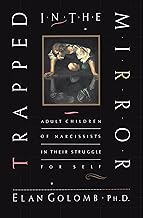Part of the Casswiki article series Books

Trapped in the Mirror: Adult Children of Narcissists in their Struggle for Self is a book by Elan Golomb, first published in 1992, which revealed the narcissism in the intrafamily relationships and struggle for self.
This book is one of FOTCM recommended readings and very important to understand ourselves as individuals. Are we independent or dependent individuals? Do we have our own “self” or a “self” created by our parents? This book brings about those issues and addressed the issue of narcissism in us, as well in others.
Narcissism is self-centered, and a narcissist sees the world as one wanted to see, not as it is. A narcissist has no care for others, but only for the self. Since we are living in a narcissist society, we would have some, if not all, narcissistic traits in ourselves and it became so without our becoming aware of them. Some of these traits include shamelessness, wishful thinking, arrogance, envy, entitlement, exploitation, and bad boundaries. When we can observe ourselves with the knowledge in this book, we can find these traits in ourselves and choose not to give into or identified with these traits.
One of the important issues from this book is the state of “invisible force”. An invisible force is the irrational influence one screened with many rationalizations and it is “what holds [one] back and prompts the most peculiar behavior” (p. 48). It is what holds us back from achieving our goals or maintaining our direction in life. It is the one that compels us to quit rather than to see it through. May it be a career, a project, or a relationship. An example of this would be a self-defeating tactic. This is common to which we have experiences with an invisible force in some instances of our lives. By being aware of this invisible force and know that it is not our conscience, we can choose not to give in to this force. The author stated that “giving in has the spirit of surrender in which you please the other by disregarding your self” (p. 236). When we do give in to an invisible force, we would become weaker and lessen our sense of self. But, when we fight the force and take a stand, we solidify our self-identity. Golomb pointed out that “a sense of self develops from interaction with people and from deeds that set you on the road” (p. 219). Our actions do indeed shape who we are.
When we are with other individuals, we tend to see some traits in them that we do not want to see in ourselves. The people whom we most dislike or uncomfortable with are the ones whose traits that we are denying in ourselves. In Golomb’s study, “to free herself, [one] needs to know in her guts, not merely in her head, that what she hates in others is the weakness she finds in herself” (p. 109). This will help us to understand that these hateful traits we must confront in order to achieve a lesson and grow. Traits are parts of our personalities. We can choose certain traits to become part of our personalities, but we can also choose not to let certain traits to control us. But, they certainly can influence us. In a sense, we can choose what trait we can act on and what trait we choose not to act on, but we cannot deny any traits of ourselves, which is considered to be hidden aspects of ourselves.
